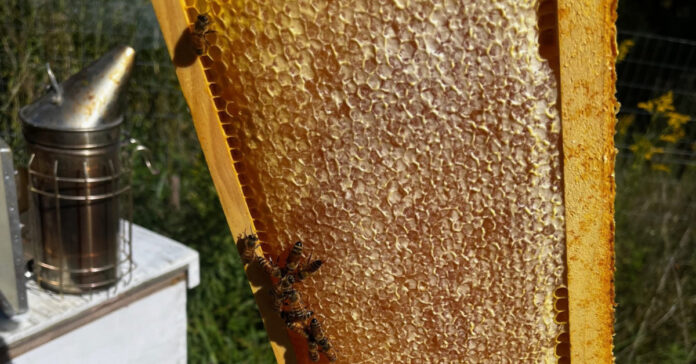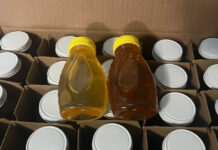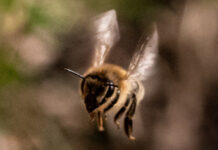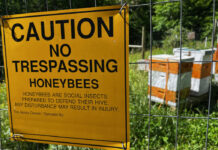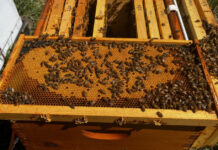Two weeks ago, I set out to treat the bees for mites, but the bees were still producing honey, so I had to put those plans on hold. That’s because the treatment I was going to use is not intended for use when there are honey supers on the hive.
Since then, we’ve gone from summer weather into fall weather. Now it’s cooler at night, with temperatures occasionally dipping into the 40s. The days are still sunny but rarely break into the 70s. The bees are still flying and there are still fields of golden rod and asters blooming, so the bees continue to bring in honey and pollen. After another two weeks, however, I didn’t want to wait any longer to treat them, so I removed the supers, leaving two full deep boxes of bees.
Winter Beehive Prep
Here’s what I did for each hive:
- If it had a super, I removed the honey frames for processing. Some frames had just a little nectar in them. I set these frames out at the opposite end of our property so the bees can rob the nectar from them. They will use it to make honey to fill any space in their hive boxes. It took them two days to clean them out.
- Then I inspected the hives. Because I don’t like to disturb the bees when they have supers on and are making honey, this was the first detailed inspection I had done since late June.
- While I was inspecting the hives, I added treatment strips to the brood box. As the bees walk over or brush against these strips, they should kill any Varroa mites.
- Then I reassembled the hives, put the inner cover on, and added an empty super to act as a spacer. Inside this empty hive body, I added flying saucer feeder to the hive, a layer of Reflectex insulation, and put the lid on. Because the bees are still a harvesting nectar, I don’t need to feed them now, but I will need to do so soon.
- When it gets colder, I will add two sheets of one-inch insulation over the feeder and under the Reflectex. I was pleased with how this worked last year.
- Bees were packed wall to wall in four of the six hives. If they had looked this good in June, I would have made more honey. Sadly, my hives peaked late. I blame our cool, wet spring.
Because there were so many bees coming and going, I did not set the entrance restrict to its smallest setting, but that will be easy to do in the future.
Run if you Smell Bananas!
When I lifted the top box on one hive, the bees came boiling out and tried to attack me. Thankfully, I was wearing my full bee suit, so I got no stings. It was the first time I had ever smelled bananas while working on a hive. I had always been told that this was what alarm pheromone smelled like, but had never experienced it before. Smelling it and seeing those angry bees made me a believer.
My advice if you smell bananas while working in or near a beehive is to leave the area. That’s what I did. I walked away and gave the bees 10 minutes to calm down. I also smoked myself and the hive. The smoke covers the smell and prevents bees from reacting to the alarm pheromone. Many beekeepers smoke the spot where a bee stung them to keep other bees from stinging them in the same area.
Heavy Lifting
Let me tell you, those top boxes were heavy. They can weigh 80 pounds or more when loaded with honey, and lifting them off and setting them aside while I inspected the lower box was no fun. I can see why some beekeepers invest in hive lifters. I am used to dealing with 50-pound feed bags, but you can’t throw a beehive over your shoulder.
Hopefully, all this weight will keep the bees well fed this winter. The combination of food, insulation, and mite treatment should put them in a good position to make it through the winter. I feel like I’ve done what I can, now it’s up to the bees.

